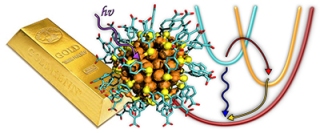Apr 14 2015
Researchers from the University of Jyväskylä’s Nanoscience Center in Finland have demonstrated that small gold nanoclusters could be utilized for short-term storage of electric charge or energy, in molecular electronics applications.
 Nanogold is different from macroscopic gold. The small 102-gold atom cluster (right) behaves like a giant molecule, but the slightly larger 144-gold atom cluster is like a metal. The image on the right is from ref. 1.
Nanogold is different from macroscopic gold. The small 102-gold atom cluster (right) behaves like a giant molecule, but the slightly larger 144-gold atom cluster is like a metal. The image on the right is from ref. 1.
Spectacular modifications have been found to take place in the electronic properties of gold of nanometre-sized chunks. These changes have been shown to take place in a specified size range.
The Jyväskylä research team has obtained important information related to development of metal-like cluster-based sensing and bioimaging. They had recently published two papers on gold nanoclusters. They showed that in quite similar but different gold nanoclusters, their electronic properties could be significantly different. The researchers used chemical methods to synthesise the clusters.
A stabilising ligand layer was incorporated on the surface of the cluster. The team observed that a cluster that had up to 102 gold atoms acted like a giant molecule. This was considered to be the smaller cluster, while a cluster that had a minimum of 144 gold atoms was considered to be a larger cluster. Though this larger cluster was in nanosize, it acted in the same manner as a macroscopic chunk of metal.
The researchers shone a laser light on the solution samples that contained the gold nanoclusters and monitored the dissipation of energy from these clusters into the solvent around them. They were able to show that the differently sized gold nanoclusters had basically different behavior.
“Molecules behave drastically different from metals,” said Professor Mika Pettersson, the principal investigator of the team conducting the experiments. “The additional energy from light, absorbed by the metal-like clusters, transfers to the environment extremely rapidly, in about one hundred billionth of a second, while a molecule-like cluster is excited to a higher energy state and dissipates the energy into the environment with a rate that is at least 100 times slower. This is exactly what we saw: the 102-gold atom cluster is a giant molecule showing even a transient magnetic state while the 144-gold atom cluster is already a metal. We’ve thus managed to bracket an important size region where this fundamentally interesting change in the behaviour takes place.”
“These experimental results go together very well with what our team has seen from computational simulations on these systems,” said Professor Hannu Häkkinen, a co-author of the studies and the scientific director of the nanoscience centre. “My team predicted this kind of behaviour back in 2008–2009 when we saw big differences in the electronic structure of exactly these nanoclusters. It’s wonderful that robust spectroscopic experiments have now proved these phenomena. In fact, the metal-like 144-atom cluster is even more interesting, since we just published a theoretical paper where we saw a big enhancement of the metallic properties of just a few copper atoms mixed with gold.”
The computational work involved in this study was performed at the HLRS centre in Stuttgart, Germany and at the CSC – the IT Center for Science in Espoo, Finland.
The Academy of Finland has provided funding for this study.